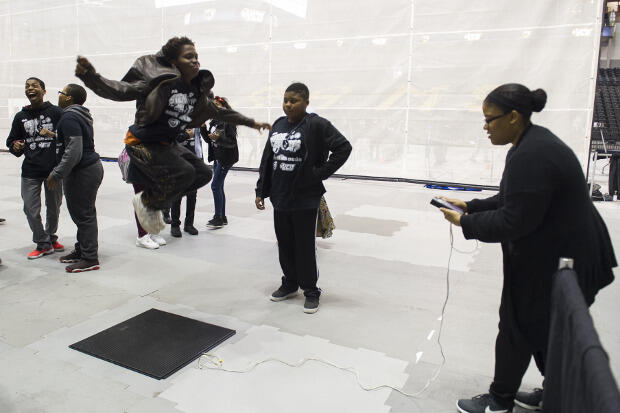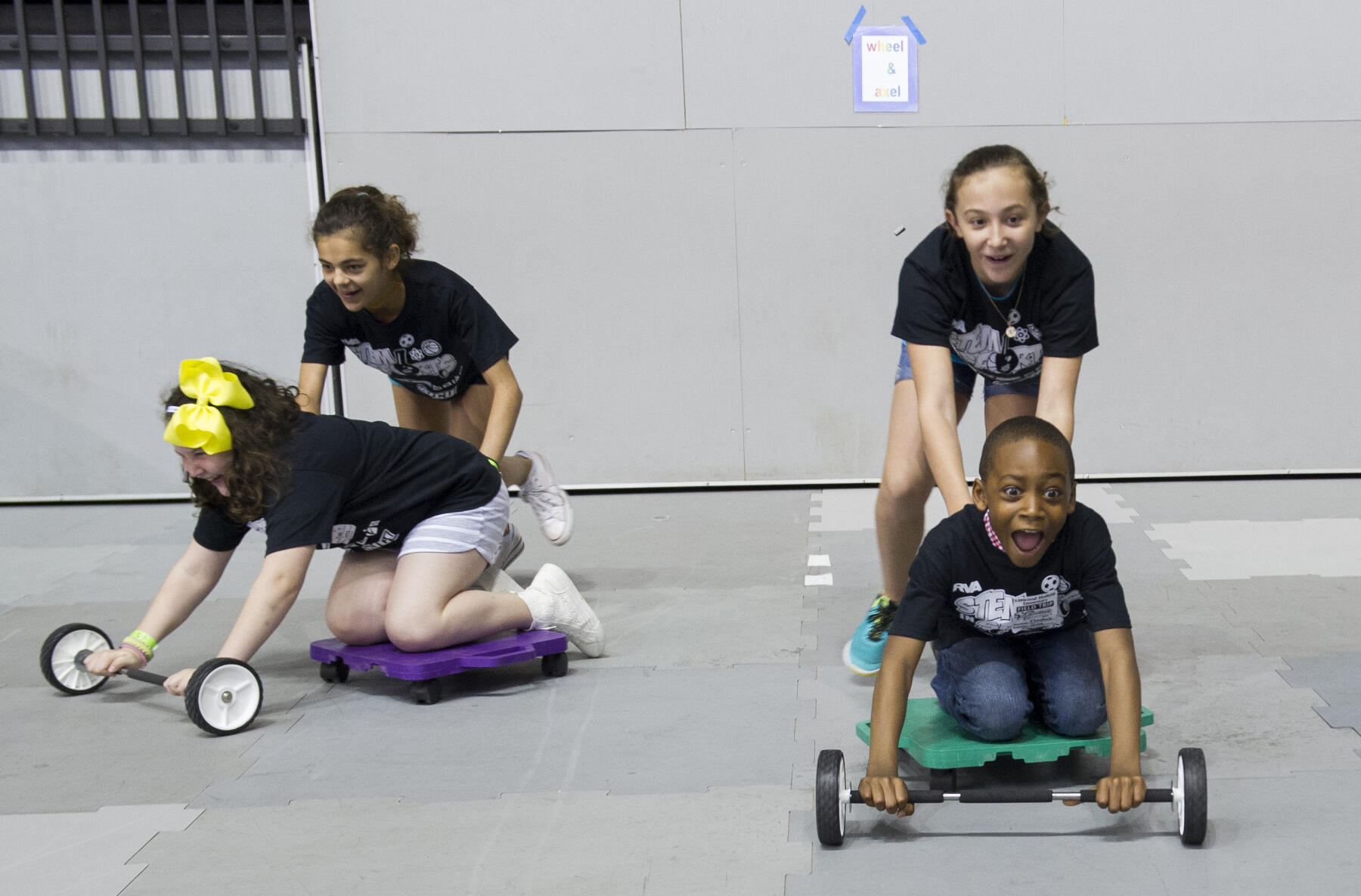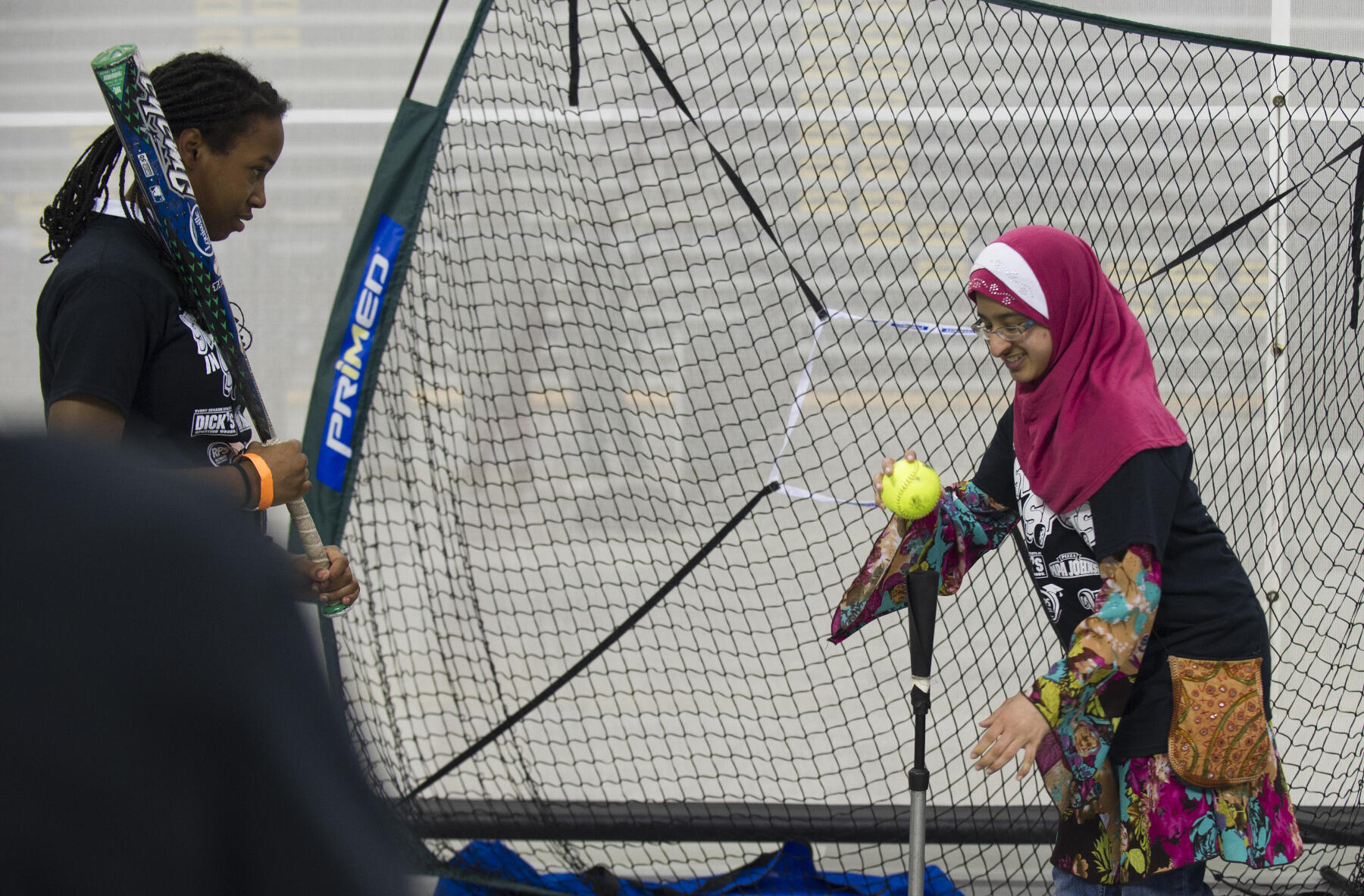
<br>photos by Julia Rendleman, University Marketing
April 5, 2017
With ‘STEM in Sports,’ VCU gives 400 Richmond Public Schools students a look at cutting-edge sports technology
Share this story
At a station on the floor of Virginia Commonwealth University’s Stuart C. Siegel Center, a group of Richmond Public Schools students hit baseballs into a net, using special bats fitted with sensors that measure the speed of their swing. At another station, kids kick soccer balls with internal chips that track the velocity and spin of the ball. And at yet another station, students shoot high-tech basketballs that calculate each shot’s arc, speed and rotation.
“We’ve got a lot of nice facilities and a lot of cool technology that we use to collect data on our student athletes,” said Tim Lampe, Ph.D., senior associate athletic director for athletic facilities with VCU Athletics. “We thought, how interesting would it be if we could connect all that with Richmond Public School’s curriculum on math, science and technology?”
On Tuesday, the VCU School of Education and VCU Athletics hosted roughly 400 students and health and physical education teachers from elementary and middle schools across Richmond for a “STEM in Sports” event that focused on a holistic, integrated approach to athletics and science, technology, engineering and math.
“The purpose of this event is to provide students with an opportunity to experience sport specific technology that is used to assess and enhance performance,” said Misti Wajciechowski, assistant professor in the Department of Teaching and Learning in the School of Education.

By tying together sports and STEM, Wajciechowski said, the event is geared both toward students who love sports, as well as those who are not necessarily the best athletes but might be inspired by seeing how science, technology, math and engineering are used in sports.
“When they come here, they’re seeing the science vocabulary, they’re seeing the technology and they’re seeing how the concepts they’re learning in science and math class are being used to help athletes get better at the sports they love,” she said. “It’s real-life learning. It’s real-life application.”
In addition to the stations that analyzed baseball, basketball and soccer, a variety of other stations gave RPS students a chance to see sports technology in action while having fun.
At one, a team from the Science Museum of Virginia let students check out remote-controlled Sphero toys, demonstrating friction, and how different surfaces can slow down or speed up the ball.
At another, the VCU Run Lab, part of the Department of Kinesiology and Health Sciences in the College of Humanities and Sciences, had the RPS students walk and run on a treadmill, while EMG sensors detected their muscle activity, which was then shown on a projector screen.
At a station demonstrating Blast Motion — sports analysis technology that uses motion analysis and video capture — VCU School of Education students used the technology to measure the RPS students’ vertical leaps, long jumps and sprints.
“We want the kids to see that sports is more than just physical strength and ability,” said Nick Dzienny, a master’s student in math education in the School of Education. “A lot of science and math goes into sports, as well. So these kind of devices give a lot of metrics, statistics and numbers that we can use to show the kids that there’s a lot more that goes into sports.”

Meanwhile, in the Basketball Development Center, the RPS students checked out the basketball team’s weight room, heard from VCU Athletics’ dietician Liz Wanamaker, learned about how sports teams use video analysis, and saw a demonstration by VCU soccer player Zeron Sewell, who was wearing a biometric sensor on his chest.
“With [the biometric] information, I know how much fitness I have,” Sewell told a group of students. “That helps me improve my performance.”
Fifty students from the School of Education helped staff the event, and many were responsible for designing a lesson on the technology to the RPS students.
The idea, Wajciechowski said, is to show future teachers an alternative way to help their students learn information.
“The elementary [education] majors, they’re going to have to teach math and science. So all of a sudden, they’re going to think, ‘Well, I did this cool thing in college. I’m going to go talk to the P.E. teacher. Or I’m going to go talk to the technology person. And now we can do something that ties together math, technology and physical education,’” she said. “It’s an interdisciplinary, cross-curricular, out-of-the-silo way of thinking and teaching.”
Elizabeth Oduro, a senior in the School of Education who studies physical education and health, helped organize the event as part of a VCU internship.
“It’s amazing to see kids engage with science, technology, math and engineering through sports — which is something they can relate to,” she said.

For the RPS students, the event is meant to hook their interest in STEM — and possible future careers — through the fun and competition of sports, said Stefanie Ramsey, Ed.D., instructional specialist, Athletics, Health & P.E., Driver Education, with Richmond Public Schools.
“It’s never too early to get a child engaged in questions like, ‘Where am I going to go in life, and what am I going to do?’ They love sports. There’s always got to be a hook. When I was in school, sports was the hook for me. I lived to play every kind of sport, every season,” she said. “A lot of our kids are in the same platform as that. But you also have the kids who aren’t necessarily about playing a sport — but they love the science and STEM side.”
It’s not about the sports. We’re using sports as the bait.
More than anything, Lampe said, organizers hope the RPS students walk away from the event having made connections between sports and what they’re learning in class.
“It’s not about the sports. We’re using sports as the bait. They’re interested in basketball, baseball and soccer and the other sports we have here today. But we want them to make the connection and look at the force, speed, spin and trajectory of the ball, and the other components they learn about in math and science class, and actually see it, touch it and understand it,” he said. “If they think they’re not good at math and science, they’re wrong. They’re good at it, they maybe just don’t know how to identify it. That’s what we’re trying to achieve today.”
Subscribe for free to the VCU News email newsletter at http://newsletter.news.vcu.edu/ and receive a selection of stories, videos, photos, news clips and event listings in your inbox every Monday and Thursday.
Subscribe to VCU News
Subscribe to VCU News at newsletter.vcu.edu and receive a selection of stories, videos, photos, news clips and event listings in your inbox.








